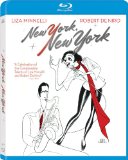World War II has just ended, and the recently discharged Robert De Niro hits New York on the prowl for sex. He runs up against WAC Liza Minnelli, and the more she resists his advances, the more determined he becomes. There is more: he is a saxophonist, and she (of course) is a singer). So begins a tempestuous relationship between two artists whose enormous talents and equally enormous personalities mean they can neither live with nor without each other.
The idea of Martin Scorsese taking on the form of the classic musical is so bizarre that it had to happen, and here it is. Scorsese’s conceit is ingenious: all the conventions are there (the meet cute, the songs, the artificial sets and colors), but they collide with the naturalism of the performances and the emotions. A perfect case in point: wandering the streets at night, De Niro sees a sailor and his girl perform a dance together. It is a classic musical moment, but the only sound is that of a train passing. It is a scene of extraordinary beauty, grit, and cinematic truth. And it belongs in an extraordinary film.
There is also, it must be said, a certain unavoidable melancholy in watching this film at a 30+ year remove from its release, and seeing its leads very much in their prime. While De Niro has, based on all available evidence, his best work behind him, he is still interesting to follow on the screen. Minnelli, sadly, isn’t nearly as lucky, but this kind of a release is, at least, a reminder of what a vital presence she once was.
Video
Scorsese had, at one point, wanted to shoot the film in 1.33:1 in order to completely capture the look of the classic musicals. He didn’t, compromising with 1.66:1, which is what we have here. In what appears to be the sole change from the most recent DVD release of the film, the aspect ratio is anamorphic, which means there is some (though not severe) loss of information on widescreen TVs. The colors are very nice, with strong flesh tones, blacks and contrasts, and there is an Old Hollywood warmth to the strong saturation.. The print is in perfect condition, at least as far as damage is concerned. But the age is showing, with grain varying from the minor to quite noticeable, and the image sometimes coming off as a bit soft. This is an instance where the upgrade from DVD to Blu-ray isn’t necessarily working in the film’s favor. As well, though the case boasts a 24 Mbps AVC codec, the actual average rate is closer to 20, dipping above and below by about 3 Mpbs depending on the scene.
For those who already have the DVD, the picture quality is the only reason to consider an upgrade (especially since the extras are exactly the same). Is it worth a re-purchase? On balance, no. The increase in definition doesn’t materially improve the look of the film, and I have to say that I was much more conscious of print grain here than I was with the DVD. On the other hand, the picture is still a very, very solid one. If you don’t already have the movie, then by all means, pick this one up.
Audio
The audio is in 5.1. The movie is from 1977. The latter turns out to be the determining characteristic. This isn’t to say that the sound is ugly. The track is clean and static-free, though there is some overmodulation going on with the dialogue. There simply isn’t much by way of surround effects, even during the crowd scenes. The music sounds fine in stereo, though it, too, doesn’t have much of a rear speaker presence. Not much, but some. There is low-key surround going on here, enough to make the audio experience richer than mere mono (an option available on the DVD, but not here).
Commentary Tracks: The same track as on the DVD, featuring Scorsese speaking with critic Carrie Rickey. The loquacious Scorsese is as enthusiastic as ever, but there are some moments where his detailed descriptions of the movies that influenced him mean that he doesn’t talk about some interesting things happening right there and then in his own film. Still, there are worse commentators to spend almost three hours with.
There is also a selected scenes commentary by DP Laszlo Kovacs, which is interesting, but only runs 10:14.
Special Features
Introduction by Martin Scorsese: (5:36) The director sets the stage nicely here, explaining what his hopes and goals for the movie were.
“The New York, New York Stories”: A two-part documentary (running 25:31 and 26:58), covering the film from inception to reception. Major participants in the interviews include Scorsese and Kovacs.
“Liza on New York, New York”: (22:09) No contributions from De Niro on the disc, but his co-star makes up for that, sharing her memories of the making of the film here.
Alternate/Deleted Scenes: (19:14) Scorsese, we learn, encouraged the actors to try different approaches to different scenes, and have some improvisational fun. So here we see what some of the discarded takes look like, along with some footage for scenes that were dropped altogether.
Theatrical Trailer and Teaser.
Closing Thoughts
This is one of those films that should have been a grand folly. Instead, it’s just grand. The Blu-ray release doesn’t really bring anything new to the table, but that changes nothing about what a fine film this is.






